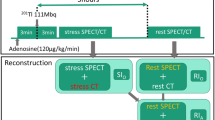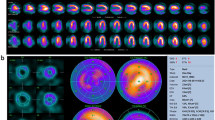Abstract
Quantitative analysis of myocardial perfusion Single photon emission computerized tomography (SPECT) images is increasingly applied in modern nuclear cardiology practice, assisting in the interpretation of myocardial perfusion images (MPI). There are different extensively validated state-of-the-art software packages, including QPS (cedars-Sinai), Corridor 4DM (University of Michigan) and Emory cardiac toolbox (Emory university), providing highly accurate and reproducible data. However, these software packages may suffer from potential artifacts related to patient or technical factors. By recognizing the source of such artifacts, the interpreting physician can avoid misinterpretation of MPI study. In this review, we discuss some of technical pitfalls that may occur in Quantitative Perfusion SPECT software (QPS, cedars-Sinai Medical center).







Similar content being viewed by others

Abbreviations
- SPECT:
-
Single photon emission computerized tomography
- MPI:
-
Myocardial perfusion imaging
- LHR:
-
Lung to heart uptake ratio
- TID:
-
Transient ischemic dilation
- LV:
-
Left ventricle
- RV:
-
Right ventricle
- ROI:
-
Region of interest
- LAD:
-
Left anterior descending coronary artery
- LCx:
-
Left circumflex coronary artery
- RCA:
-
Right coronary artery
References
Underwood SR, Anagnostopoulos C, Cerqueira M, Ell PJ, Flint EJ, Harbinson M, et al. Myocardial perfusion scintigraphy: The evidence. Eur J Nucl Med Mol Imaging 2004;31:261-91.
Faber TL, Chen JI, Garcia EV. SPECT processing, quantification, and display. In: Zaret BL, Beller GA, editors. Clinical nuclear cardiology: State of the art and future directions. 2010. p. 53-71.
Cullom SJ, Case JA, Bateman TM. Electrocardiographically gated myocardial perfusion SPECT: Technical principles and quality control considerations. J Nucl Cardiol 1998;5:418-25.
Malek H, Ghaedian T, Yaghoobi N, Rastgou F, Bitarafan-Rajabi A, Firoozabadi H. Focal breast uptake of 99mTc-sestamibi in a man with spindle cell lipoma. J Nucl Cardiol 2012;19(3):618-20.
Berman DS, Kang X, Gransar H, Gerlach J, Friedman JD, Hayes SW, et al. Quantitative assessment of myocardial perfusion abnormality on SPECT myocardial perfusion imaging is more reproducible than expert visual analysis. J Nucl Cardiol 2009;16:45-53.
Burrell S, MacDonald A. Artifacts and pitfalls in myocardial perfusion imaging. J Nucl Med Technol 2006;34:193-211.
Russell RR, Wackers FJT. Coronary Artery Disease Detection: Exercise Stress SPECT. In: Zaret BL, Beller GA, editors. Clinical nuclear cardiology: State of the art and future directions. Philadelphia: Elsevier; 2010. p. 225-43.
Martinez EE, Horowitz SF, Castello HJ, Castiglioni ML, Carvalho AC, Almeida DR, et al. Lung and myocardial thallium-201 kinetics in resting patients with congestive heart failure: Correlation with pulmonary capillary wedge pressure. Am Heart J 1992;123:427-32.
Germano G, Kavanagh PB, Slomka PJ, Van Kriekinge SD, Pollard G, Berman DS. Quantitation in gated perfusion SPECT imaging: The Cedars-Sinai approach. J Nucl Cardiol 2007;14:433-54.
Germano G, Kavanagh PB, Su HT, Mazzanti M, Kiat H, Hachamovitch R, et al. Automatic reorientation of three-dimensional, transaxial myocardial perfusion SPECT images. J Nucl Med 1995;36:1107-14.
Goel S, Bommireddipalli S, DePuey EG. Effect of proton pump inhibitors and H2 antagonists on the stomach wall in 99mTc-sestamibi cardiac imaging. J Nucl Med Technol 2009;37:240-3.
Williams KA, Schuster RA, Williams KA Jr, Schneider CM, Pokharna HK. Correct spatial normalization of myocardial perfusion SPECT improves detection of multivessel coronary artery disease. J Nucl Cardiol 2003;10:353-60.
Xu Y, Kavanagh P, Fish M, Gerlach J, Ramesh A, Lemley M, et al. Automated quality control for segmentation of myocardial perfusion SPECT. J Nucl Med 2009;50:1418-26.
Slomka PJ, Berman DS, Germano G. Quantification of myocardial perfusion. In: Germano G, Berman DS, editors. Clinical Gated Cardiac SPECT. New York: Wiley; 2006. p. 69-91.
Williams KA, Schneider CM. Increased stress right ventricular activity on dual isotope perfusion SPECT: A sign of multivessel and/or left main coronary artery disease. J Am Coll Cardiol 1999;34:420-7.
Hansen C, Goldstein R, Akinboboye O, Berman D, Botvinick E, Churchwell K, et al. Myocardial perfusion and function: Single photon emission computed tomography. J Nucl Cardiol 2007;14:e39-60.
Garcia EV. SPECT attenuation correction: An essential tool to realize nuclear cardiology’s manifest destiny. J Nucl Cardiol 2007;14:16-24.
Slomka PJ, Nishina H, Berman DS, Akincioglu C, Abidov A, Friedman JD, et al. Automated quantification of myocardial perfusion SPECT using simplified normal limits. J Nucl Cardiol 2005;12:66-77.
Nakajima K, Okuda K, Kawano M, Matsuo S, Slomka P, Germano G, et al. The importance of population-specific normal database for quantification of myocardial ischemia: Comparison between Japanese 360 and 180-degree databases and a US database. J Nucl Cardiol 2009;16:422-30.
Pereztol-Valdés O, Candell-Riera J, Cs Santana-Boado, Angel J, Aguadé-Bruix S, Castell-Conesa J, et al. Correspondence between left ventricular 17 myocardial segments and coronary arteries. Eur Heart J 2005;26:2637-43.
Thomas GS, Kawanishi DT. Situs inversus with dextrocardia in the nuclear lab. Am Heart Hosp. J 2008;6:60-2.
Disclosures
The authors report no conflicts of interest.
Author information
Authors and Affiliations
Corresponding author
Rights and permissions
About this article
Cite this article
Malek, H., Yaghoobi, N. & Hedayati, R. Artifacts in Quantitative analysis of myocardial perfusion SPECT, using Cedars-Sinai QPS Software. J. Nucl. Cardiol. 24, 534–542 (2017). https://doi.org/10.1007/s12350-016-0726-6
Received:
Accepted:
Published:
Issue Date:
DOI: https://doi.org/10.1007/s12350-016-0726-6



